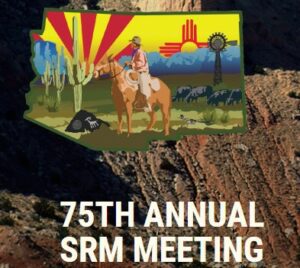Sagebrush
View bibliography.
This Science for Resource Managers tool provides online, searchable access to multiple published annotated bibliographies on priority management topics for resource managers, currently focused primarily on issues relevant to lands in the western U.S.
High school youth are invited to enjoy a week of fun, camping and learning about rangelands and natural resource management in Nevada. Camp will be held at the Timber Creek Campground providing a beautiful setting for learning. The purpose of this camp is to provide youth with the knowledge and understanding of how decisions are made about natural resources on Nevada’s rangelands.
The last camp was June 19-26, 2022 at Timber Creek Campground northeast of McGill, NV.
This camp is sponsored by the Nevada Section of the Society for Range Management. See https://nevada.rangelands.org/youth-range-camp/
for more details and application materials.
Contact Camp Director Ethan Mower with questions at emower@parks.nv.gov | 775-726-3564
View article.
This study demonstrates the importance of episodic periods of favorable weather for long-term plant population recovery following disturbance. Management strategies that increase opportunities for seed availability to coincide with favorable weather conditions, such as retaining unburned patches or repeated seeding treatments, can improve restoration outcomes in high-priority areas.
View article.
During the first years after removal of perennial grasses and forbs, there was an increase in soil water availability in spring at 13–30 cm soil depth that was associated with sagebrush establishment, particularly at upper elevations. In subsequent years, sagebrush continued to dominate even though little difference in soil water availability existed between disturbed and undisturbed plots. This indicates that quickly establishing sagebrush preempted resources and reduced perennial herb recovery. Resource preemption after disturbance will likely be a major driver of plant succession in the future as in the past. Species that establish best under future warmer and drier conditions are most likely to dominate after disturbance. A negative correlation (r2 = 0.34) between the standard deviation of annual spring soil water availability and perennial vegetation cover, which helps resist annual grass invasion, supports the hypothesis that greater resource fluctuation is associated with greater plant community invasibility. Current responses to fire and loss of native plant cover across elevational gradients can indicate future responses under a warmer and drier climate.
View article.
Treatments in cooler and moister woodland sites had more positive effects on sagebrush recruitment and perennial grass cover, less negative effects on sagebrush intraspecific interactions, and smaller increases in annual grass cover indicating potential increases in resilience to fire. In warmer and drier invasion sites, reductions in woody fuels resulted in lack of sagebrush recruitment, disruption of sagebrush intraspecific interactions, and progressive increases in annual grass indicating reduced resilience to fire and resistance to invaders.
View article.
The encroachment of pinyon-juniper woodlands into sagebrush habitat in the Great Basin Ecoregion of the western USA, represents a potential source of habitat degradation for sagebrush-associated wildlife species. To restore sagebrush habitat, managers are conducting large-scale conifer removal efforts within the Great Basin, particularly within Greater Sage-Grouse (Centrocercus urophasianus) priority areas for conservation. Such largescale habitat modification efforts may result in unintended ecological trade-offs for wildlife. To investigate these trade-offs, we used community science data to develop species distribution models for two sagebrush and three pinyon-juniper associated bird species of conservation concern in the Great Basin. We evaluated the predictive performance of our models with an independent dataset of presence locations derived from systematic monitoring programs. We then simulated conifer removal across the Great Basin and mapped habitat gains and losses for our study species. Despite differing land cover associations, 31%-51% of suitable habitat for our study species coincided with Greater Sage-Grouse priority areas for conservation. Our conifer removal scenario increased suitable habitat by 6%-17% for sagebrush associates and reduced habitat by 11%-41% for pinyon-juniper associates. We identified areas of the Great Basin where conifer removal expanded habitat for sagebrush associates without concurrent habitat loss for pinyon-juniper associates. Our results provide guidance for conducting vegetation management in the Great Basin while addressing the habitat needs for multiple focal species. Our methods, which use freely available community science data and geospatial layers, can easily be transferred to other species and ecoregions.
Meeting website.
Join us in the heart of New Mexico for the 75th Annual SRM Meeting. The beautiful high desert rangelands, diverse cultures, authentic art, and painted skies of Albuquerque will make for a great meeting.
Approximately 70 park units include at least some sagebrush shrublands or steppe, but we identified 40 parks with substantial amounts (>20% of park area) that can be included in an agency-wide conservation strategy. Second, we examined detailed patterns of resilience and resistance, fire history and fire risk, cheatgrass (Bromus tectorum) invasion, and sagebrush shrub (Artemisia spp.) persistence in five national park units in Columbia Basin and Snake River Plain sagebrush steppe, contextualized by the broader summary. In these five parks, fire frequency and size increased in recent decades. Cheatgrass invasion and sagebrush persistence correlated strongly with resilience, burn frequency (0–3 fires since ~1940), and burn probability, but with important variation, in part mediated by local-scale topography. Third, we used these insights to assemble strategic sagebrush ecosystem fire protection mapping scenarios in two additional parks – Lava Beds National Monument and Great Basin National Park. Readily available and periodically updated geospatial data including soil surveys, fire histories, vegetation inventories, and long-term monitoring support resiliency-based adaptive management through tactical planning of pre-fire protection, post-fire restoration, and triage. Our assessment establishes the precarious importance of the US national park system to sagebrush ecosystem conservation and an operational strategy for place-based and science-supported conservation.
View article.
Here, we used two complementary models to explore spatial and temporal relationships in the potential of big sagebrush regeneration representing (1) range-wide big sagebrush regeneration responses in natural vegetation (process-based model) and (2) big sagebrush restoration seeding outcomes following fire in the Great Basin and the Snake River Plains (regression-based model). The process-based model suggested substantial geographic variation in long-term regeneration trajectories with central and northern areas of the big sagebrush region remaining climatically suitable, whereas marginal and southern areas are becoming less suitable. The regression-based model suggested, however, that restoration seeding may become increasingly more difficult, illustrating the particularly difficult challenge of promoting sagebrush establishment after wildfire in invaded landscapes. These results suggest that sustaining big sagebrush on the landscape throughout the 21st century may climatically be feasible for many areas and that uncertainty about the long-term sustainability of big sagebrush may be driven more by dynamics of biological invasions and wildfire than by uncertainty in climate change projections. Divergent projections of the two models under 21st century climate conditions encourage further study to evaluate potential benefits of re-creating conditions of uninvaded, unburned natural big sagebrush vegetation for post-fire restoration seeding, such as seeding in multiple years and, for at least much of the northern Great Basin and Snake River Plains, the control of the fire-invasive annual grass cycle.






